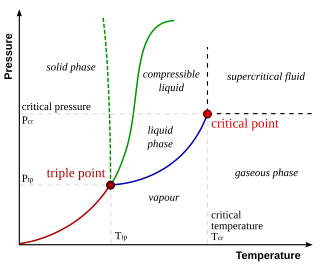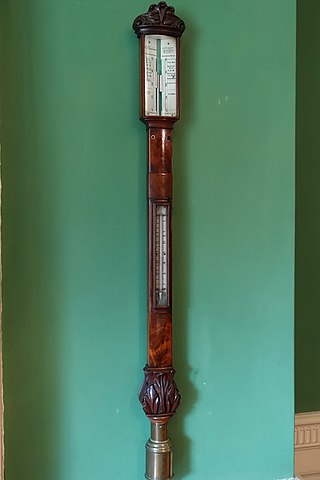Related Research Articles

Pressure measurement is the measurement of an applied force by a fluid on a surface. Pressure is typically measured in units of force per unit of surface area. Many techniques have been developed for the measurement of pressure and vacuum. Instruments used to measure and display pressure mechanically are called pressure gauges,vacuum gauges or compound gauges. The widely used Bourdon gauge is a mechanical device, which both measures and indicates and is probably the best known type of gauge.

Pressure is the force acting normally per unit area on an object surface-by Lewis junior 2024 Gauge pressure is the pressure relative to the ambient pressure.
Standard temperature and pressure (STP) are various standard sets of conditions for experimental measurements used to allow comparisons to be made between different sets of data. The most used standards are those of the International Union of Pure and Applied Chemistry (IUPAC) and the National Institute of Standards and Technology (NIST), although these are not universally accepted. Other organizations have established a variety of other definitions.

In thermodynamics, the triple point of a substance is the temperature and pressure at which the three phases of that substance coexist in thermodynamic equilibrium. It is that temperature and pressure at which the sublimation, fusion, and vaporisation curves meet. For example, the triple point of mercury occurs at a temperature of −38.8 °C (−37.8 °F) and a pressure of 0.165 mPa.

United States customary units form a system of measurement units commonly used in the United States and most U.S. territories, since being standardized and adopted in 1832. The United States customary system developed from English units that were in use in the British Empire before the U.S. became an independent country. The United Kingdom's system of measures was overhauled in 1824 to create the imperial system, which was officially adopted in 1826, changing the definitions of some of its units. Consequently, while many U.S. units are essentially similar to their imperial counterparts, there are noticeable differences between the systems.
Atmospheric pressure, also known as air pressure or barometric pressure, is the pressure within the atmosphere of Earth. The standard atmosphere is a unit of pressure defined as 101,325 Pa (1,013.25 hPa), which is equivalent to 1,013.25 millibars, 760 mm Hg, 29.9212 inches Hg, or 14.696 psi. The atm unit is roughly equivalent to the mean sea-level atmospheric pressure on Earth; that is, the Earth's atmospheric pressure at sea level is approximately 1 atm.

A barometer is a scientific instrument that is used to measure air pressure in a certain environment. Pressure tendency can forecast short term changes in the weather. Many measurements of air pressure are used within surface weather analysis to help find surface troughs, pressure systems and frontal boundaries.

The pascal is the unit of pressure in the International System of Units (SI). It is also used to quantify internal pressure, stress, Young's modulus, and ultimate tensile strength. The unit, named after Blaise Pascal, is a SI coherent derived unit defined as one newton per square metre (N/m2). It is also equivalent to 10 barye in the CGS system. Common multiple units of the pascal are the hectopascal, which is equal to one millibar, and the kilopascal, which is equal to one centibar.

The bar is a metric unit of pressure defined as 100,000 Pa (100 kPa), though not part of the International System of Units (SI). A pressure of 1 bar is slightly less than the current average atmospheric pressure on Earth at sea level. By the barometric formula, 1 bar is roughly the atmospheric pressure on Earth at an altitude of 111 metres at 15 °C.
The standard atmosphere is a unit of pressure defined as 101325 Pa. It is sometimes used as a reference pressure or standard pressure. It is approximately equal to Earth's average atmospheric pressure at sea level.
A centimetre or millimetre of water are less commonly used measures of pressure based on the pressure head of water.

A millimetre of mercury is a manometric unit of pressure, formerly defined as the extra pressure generated by a column of mercury one millimetre high, and currently defined as exactly 133.322387415 pascals or exactly 133.322 pascals. It is denoted mmHg or mm Hg.

Hydraulic head or piezometric head is a specific measurement of liquid pressure above a vertical datum.
Inch of mercury is a non-SI unit of measurement for pressure. It is used for barometric pressure in weather reports, refrigeration and aviation in the United States.
A standard cubic foot (scf) is a unit representing the amount of gas (such as natural gas) contained in a volume of one cubic foot at reference temperature and pressure conditions. It is the unit commonly used when following the customary system, a collection of standards set by the National Institute of Standards and Technology. Another unit used for the same purpose is the standard cubic metre (Sm3), derived from SI units, representing the amount of gas contained in a volume of one cubic meter at different reference conditions. The reference conditions depend on the type of gas and differ from other standard temperature and pressure conditions.
Copper units of pressure or CUP, and the related lead units of pressure or LUP, are terms applied to pressure measurements used in the field of internal ballistics for the estimation of chamber pressures in firearms. These terms were adopted by convention to indicate that the pressure values were measured by copper crusher and lead crusher gauges respectively. In recent years, they have been replaced by the adoption of more modern piezoelectric pressure gauges that more accurately measure chamber pressures and generally give significantly higher pressure values. This nomenclature was adopted to avoid confusion and the potentially dangerous interchange of pressure values and standards made by different types of pressure gauges. For example, it makes little sense to describe a maximum pressure as 300 MPa, and in case the pressure has been measured according to the CUP procedure it should be denoted as 300 MPa (CUP).
In fluid mechanics, pressure head is the height of a liquid column that corresponds to a particular pressure exerted by the liquid column on the base of its container. It may also be called static pressure head or simply static head.

The pound per square inch or, more accurately, pound-force per square inch, is a unit of measurement of pressure or of stress based on avoirdupois units. It is the pressure resulting from a force with magnitude of one pound-force applied to an area of one square inch. In SI units, 1 psi is approximately 6,895 pascals.
Within firearms, chamber pressure is the pressure exerted by a cartridge case's outside walls on the inside of a firearm's chamber when the cartridge is fired. The SI unit for chamber pressure is the megapascal (MPa), while the American SAAMI uses the pound per square inch and the European CIP uses bar.

The metresea water (msw) is a metric unit of pressure used in underwater diving. It is defined as one tenth of a bar.
References
- ↑ "My pressure gauge is scaled in 'inches' - what does this mean?" http://www.npl.co.uk/science-technology/mass-and-force/faqs/
- ↑ "The International System of Units (SI) – Conversion Factors for General Use" (PDF). 2006. p. 12. Archived from the original (PDF) on 2017-10-05. Retrieved 2017-10-05.
- 1 2 Guide for the Use of the International System of Units (SI) (PDF). 2008. p. 50.